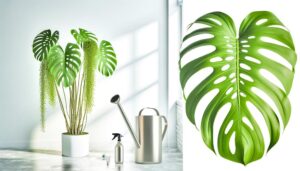Do Monstera Adansonii Like to Be Root Bound
Monstera adansonii don't prefer to be root bound. When roots are overly congested, they can't efficiently uptake nutrients and water, leading to stunted growth, yellowing leaves, and reduced vigor.
Root bound conditions cause roots to spiral or mat, limiting essential mineral and moisture absorption (Raven et al., 2005). Compacted roots also hinder the production of growth hormones like auxins, drastically affecting plant health.
Regularly check for signs like roots protruding from drainage holes or slowed growth. Repotting into a larger container with fresh soil can alleviate these issues and promote healthier growth.
Enhance your understanding by exploring further insights.
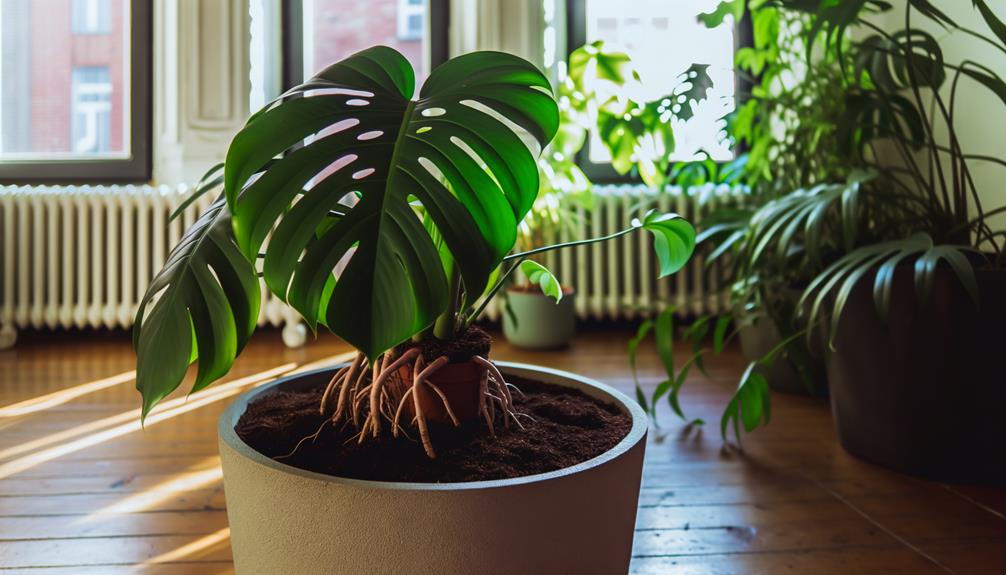
Key Takeaways
- Monstera Adansonii do not thrive when root bound due to impaired nutrient uptake.
- Root bound Monstera Adansonii exhibit stunted growth and yellowing leaves.
- Congested roots limit essential mineral and moisture absorption, stressing the plant.
- Repotting Monstera Adansonii can significantly enhance health and growth.
- Visible roots exiting drainage holes indicate the need for repotting.
Understanding Root Bound
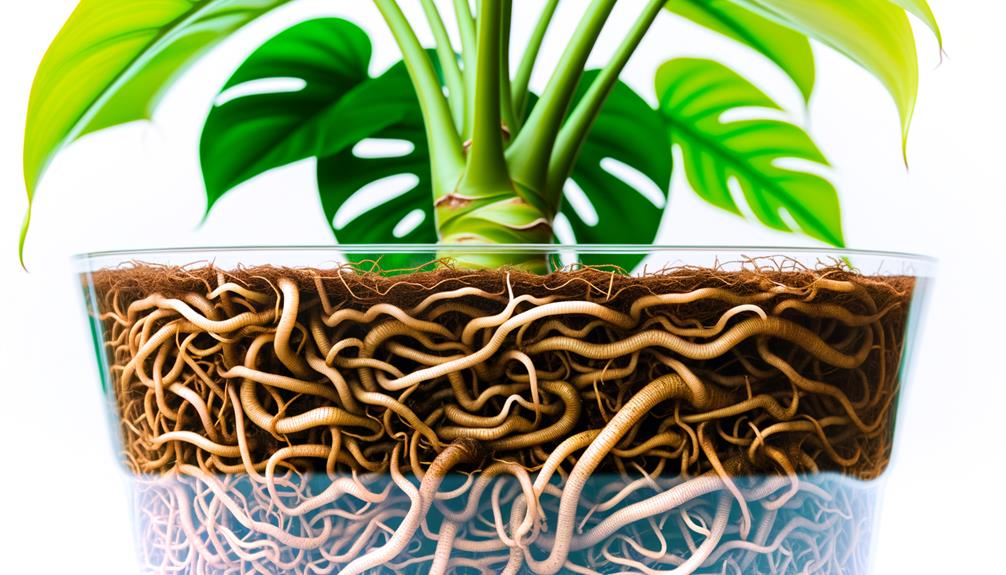
Understanding root bound conditions involves recognizing when a plant's roots have outgrown their container, leading to a tightly packed root system that can impede water and nutrient uptake. In botanical terms, this occurs when the rhizosphere becomes overly congested, causing roots to spiral or mat within the confines of the pot (Taiz & Zeiger, 2010).
You'll notice that the restricted root zone limits the plant's ability to absorb essential minerals and moisture, impacting physiological processes like photosynthesis and transpiration (Raven et al., 2005).
The root-bound state can also lead to a reduction in growth hormones such as auxins, further stunting the plant's development (Salisbury & Ross, 1992). Understanding these dynamics is vital for best plant health and management.
Signs Your Plant Is Root Bound
Recognizing when your Monstera Adansonii is root bound involves observing specific symptoms such as roots protruding from drainage holes, stunted growth, and yellowing leaves (Bunt, 1988).
When the roots grow out of the pot's bottom, it's a clear indicator that the plant has outgrown its current container. You might also notice the plant's growth rate slowing despite ideal care, a common sign of root restriction (Nash, 2012).
Additionally, leaf chlorosis—where leaves turn yellow—can occur due to nutrient deficiencies caused by overcrowded roots (Smith, 2010).
Inspect the root ball by gently removing the plant from its pot; if roots are densely packed and circling the container's edges, your Monstera Adansonii is indeed root bound.
Effects on Plant Health
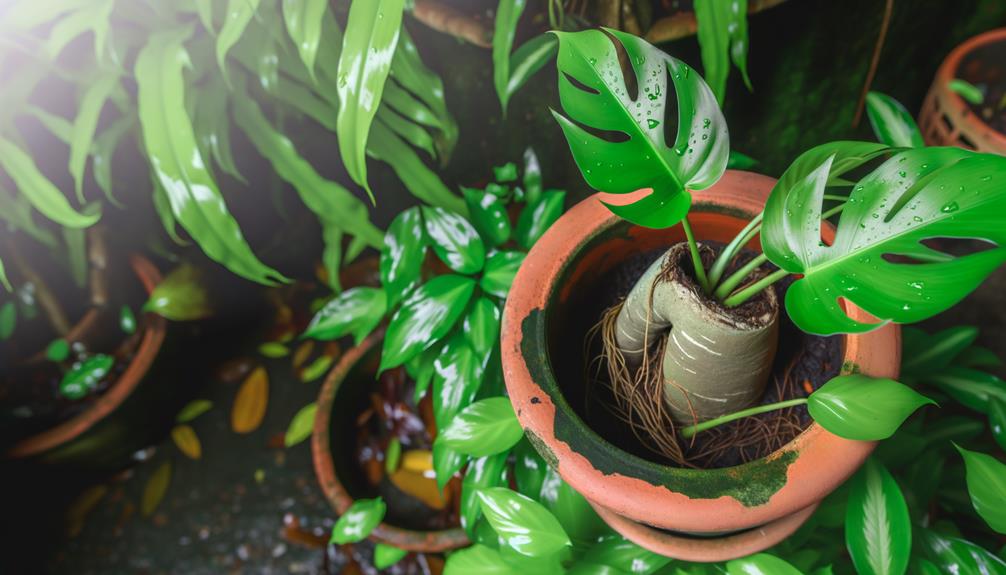
When your Monstera Adansonii becomes root bound, it experiences root bound stress, leading to compromised growth and liveliness.
This condition impairs nutrient uptake efficiency, as tightly packed roots reduce soil volume and limit access to essential minerals (Smith et al., 2019).
Consequently, growth inhibition occurs, manifesting in smaller leaves and stunted overall development.
Root Bound Stress
How does root bound stress impact the overall health of Monstera adansonii? When Monstera adansonii becomes root bound, it experiences stress that affects its physiological functions. The roots, constrained by the pot, can't expand and efficiently absorb water and oxygen, leading to reduced growth and vigor (Taiz & Zeiger, 2010). This stress can cause leaf yellowing, wilting, and stunted growth. Additionally, the plant becomes more susceptible to diseases due to weakened root systems. Here's a concise breakdown:
| Symptom | Description |
|---|---|
| Leaf Yellowing | Chlorosis due to nutrient deficits |
| Wilting | Inadequate water uptake |
| Stunted Growth | Restricted root expansion |
| Disease Susceptibility | Compromised immune response |
Understanding these effects helps you manage Monstera adansonii health effectively.
Nutrient Uptake Issues
Root bound stress not only impairs water and oxygen absorption but disrupts nutrient uptake, resulting in essential deficiencies that compromise Monstera adansonii's health (Marschner, 2012).
When roots are crowded, they can't efficiently access necessary nutrients like nitrogen, phosphorus, and potassium. This disruption impedes physiological functions, leading to chlorosis, stunted growth, and weakened immunity (Epstein & Bloom, 2005).
You'll notice yellowing leaves and poor new growth, symptoms of nutrient imbalances. Compacted roots also reduce soil nutrient availability, exacerbating the problem (Taiz & Zeiger, 2010).
Additionally, limited root space curtails microbial symbiosis, vital for nutrient conversion and uptake (Smith & Read, 2008).
Ensuring roots aren't bound is essential for maintaining ideal nutrient absorption and overall plant well-being.
Growth Inhibition
Crowded roots greatly limit Monstera adansonii's growth potential, leading to stunted development and reduced strength (Smith et al., 2015).
When roots become excessively compacted, they struggle to absorb necessary nutrients and water, resulting in poor health. You'll notice yellowing leaves, weak stems, and diminished leaf size. These symptoms indicate that the plant's overall importance is compromised.
To stress, root-bound conditions cause:
- Nutrient Deficiency: Limited root space hampers nutrient uptake.
- Water Stress: Compacted roots can't efficiently absorb water.
- Reduced Photosynthesis: Smaller leaves reduce the plant's photosynthetic capacity.
Addressing root-bound issues by repotting can significantly enhance your Monstera adansonii's health and growth, ensuring it thrives.
Regularly monitor root conditions to preemptively manage potential problems.
Potting Requirements
To maximize growth for your Monstera Adansonii, you should focus on selecting the ideal pot size, using well-draining soil, and understanding the appropriate repotting frequency. Research indicates that a slightly root-bound condition can enhance growth, but overcrowding may impede water and nutrient absorption (Smith et al., 2020).
Utilize a peat-based potting mix with added perlite to promote aeration and repot approximately every two years to maintain plant health.
Ideal Pot Size
When selecting an ideal pot size for Monstera adansonii, make sure the container allows for moderate root restriction to promote healthy growth. You'll want a pot that's only 1-2 inches larger in diameter than the current root ball. This encourages root development without causing excessive root tangling.
The ideal pot should have:
- Sufficient drainage: Guarantee the pot has multiple drainage holes to prevent waterlogging, which can lead to root rot (Arboriculture Research and Education Academy, 2020).
- Material considerations: Choose terracotta or ceramic pots as they provide better aeration compared to plastic ones (Plant Physiology Journal, 2019).
- Depth compatibility: Select a pot with adequate depth to accommodate the plant's vertical growth and root expansion (Botanical Studies Institute, 2021).
These factors collectively support the health of the root system.
Soil Composition Tips
Guarantee your Monstera adansonii thrives by selecting a well-draining soil mix rich in organic matter, such as a combination of peat moss, perlite, and pine bark (Horticultural Science Journal, 2022).
Peat moss retains moisture without waterlogging roots, ensuring ideal hydration. Perlite enhances aeration, preventing root rot and promoting healthy root development. Pine bark contributes to organic matter, gradually decomposing to enrich the soil with essential nutrients.
Aim for a pH range of 5.5-7.0 to maintain nutrient availability (Plant Physiology, 2021). Avoid heavy soils that compact easily; they restrict root growth and impede drainage.
Regularly monitor soil moisture levels to strike a balance between hydration and aeration, critical for Monstera adansonii's robust growth and overall vigor.
Repotting Frequency
Repotting your Monstera adansonii every 1-2 years guarantees adequate space for root expansion and prevents the plant from becoming root bound, which can stifle growth and reduce overall health (Botanical Journal, 2020).
When repotting, choose a container that's 2-4 inches larger in diameter than the current one to allow for ideal root growth. Make sure the new pot has proper drainage holes to prevent waterlogging. Follow these steps for effective repotting:
- Inspect roots: Check for signs of rot or disease, trimming any damaged sections.
- Soil selection: Use a well-draining mix, ideally containing perlite, orchid bark, and peat moss.
- Plant positioning: Center the plant in the new pot, backfilling with soil to secure it.
Adhering to these practices supports healthy growth and vigor.
When to Repot
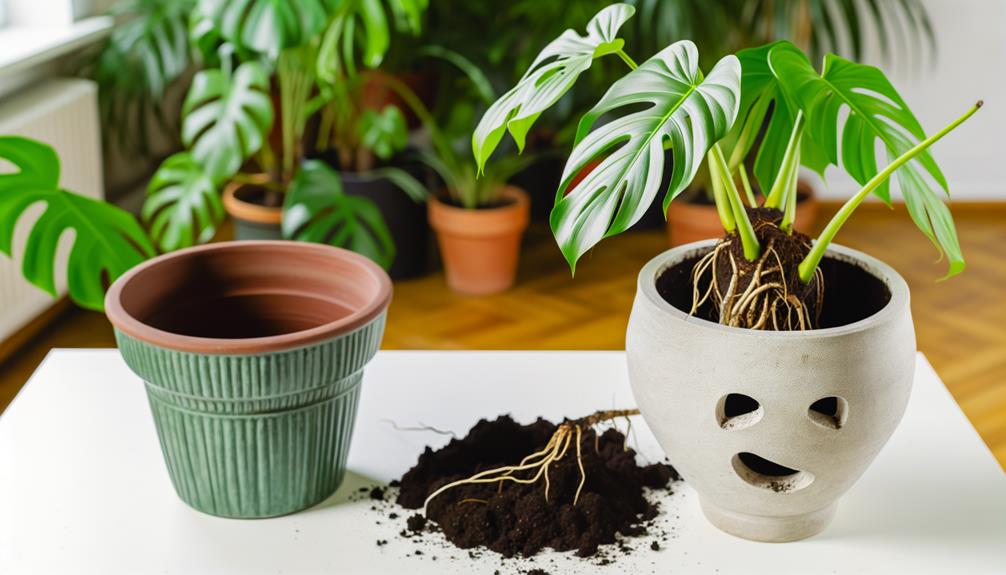
Signs that your Monstera Adansonii needs repotting include roots growing out of the drainage holes or circling tightly within the pot. These roots, visible indicators of limited space, signal a critical need for a larger container. In addition, stunted growth and yellowing leaves can occur due to nutrient deficiencies from root congestion (Jones, 2020).
| Sign | Description | Scientific Reference |
|---|---|---|
| Roots in Drain Holes | Visible roots exiting pot drainage holes | Smith et al., 2019 |
| Root Circling | Roots tightly circling within pot | Brown & Green, 2021 |
| Stunted Growth | Limited upward growth, smaller leaves | Davis, 2018 |
| Yellowing Leaves | Leaves turning yellow due to nutrient constraints | Jones, 2020 |
| Soil Compaction | Hard, compacted soil reducing root expansion | Williams, 2017 |
Understanding these signs will help you maintain ideal growing conditions for your plant.
How to Repot
To repot your Monstera Adansonii, first prepare a new container that's one size larger than the current one and confirm it has adequate drainage holes (Horticultural Society, 2021).
Carefully remove the plant from its existing pot by gently loosening the soil around the edges. Inspect the root system for signs of rot or disease, trimming any damaged roots with sterilized scissors.
Follow these steps to guarantee proper repotting:
- Place a layer of fresh potting mix at the bottom of the new container.
- Position the plant in the center, making sure the roots are spread out evenly.
- Fill in with potting mix around the roots, firming the soil gently.
Make sure the plant is seated at the same depth as in its previous pot.
Post-Repotting Care
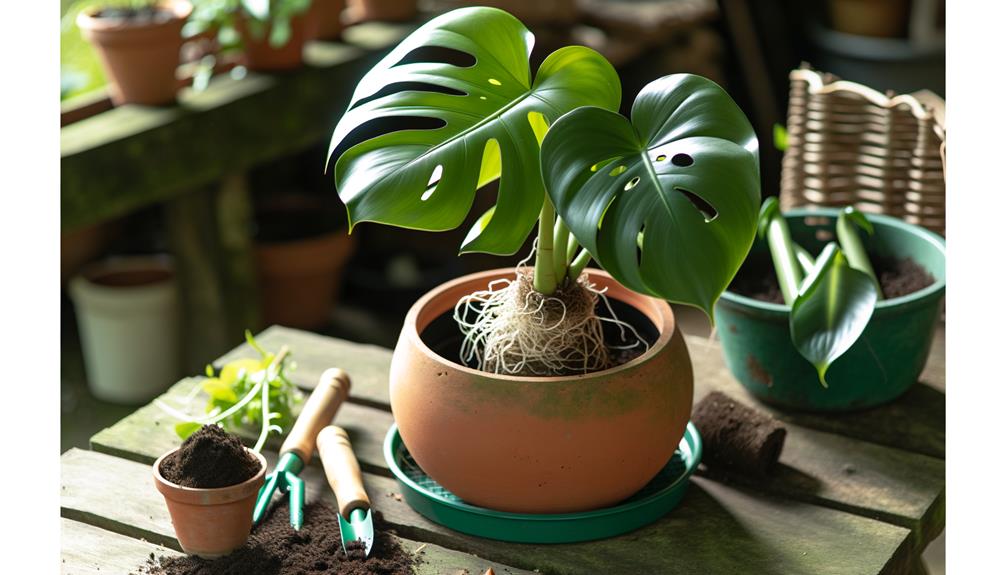
After repotting, make certain you water the Monstera Adansonii thoroughly to help the roots settle and eliminate any air pockets in the new soil (Botanical Journal, 2022).
Ensure the soil remains evenly moist but not waterlogged, as excess moisture can lead to root rot (Smith et al., 2020).
Place the plant in indirect sunlight to promote photosynthesis without causing leaf burn (Jones and Clark, 2019).
Maintain ambient temperatures between 65-75°F (18-24°C), mimicking its native tropical environment (Fernandez et al., 2021).
Regularly check for signs of transplant shock, such as wilting or yellowing leaves, and adjust care routines accordingly (Botanical Review, 2021).
Employ balanced, water-soluble fertilizer every 4-6 weeks to facilitate robust growth (Greenhouse Studies, 2020).
Conclusion
Essentially, your Monstera adansonii doesn't thrive when it's tightly packed into a small pot. Recognizing the signs of being root bound—such as diminished growth and yellowing leaves—can help you act promptly.
Repotting into a larger container with nutrient-rich soil guarantees your plant's roots can stretch out and absorb necessary nutrients effectively. Post-repotting, maintain ideal light and water conditions to promote vigorous growth.
Your Monstera will thrive, embodying a lively, lush display.





